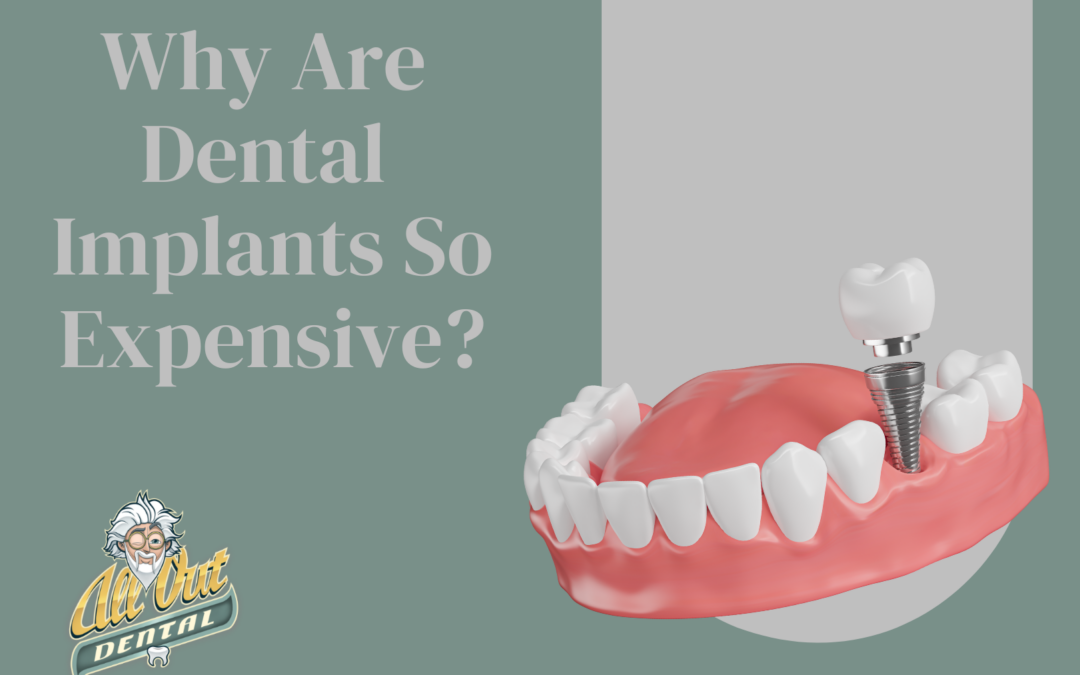For many denture wearers, the idea of transitioning to dental implants is appealing but often met with hesitation due to the high costs involved. The question, “Why are dental implants so expensive?” is a common and valid concern. Understanding the factors contributing to these costs can help illuminate why dental implants are considered a worthwhile investment despite their initial expense.
Explaining the High Costs
Supplies and Materials
The high cost of dental implants begins with the materials used. Unlike other tooth replacement options, dental implants involve components that are significantly more expensive:
- Titanium Screw: The implant itself is a titanium screw placed into the jawbone, costing the dentist up to $500.
- Abutment and Crown: The crown attaches to the screw via an abutment, with the abutment costing about $100 and the crown around $200, depending on the lab.
- Surgical Guide: A surgical guide, which ensures precise placement of the implant, can add another $200 to the cost.
- Bone Grafting and Membranes: In some cases, additional bone grafting and membranes are necessary, adding over $100 to the expenses.
Equipment and Technology
The technology necessary to perform dental implant procedures also adds to the overall cost:
- 3D CBCT Scanner: To get a detailed view of the bone and nerves, a 3D CBCT scanner is required, with costs reaching up to $100,000.
- Intraoral Scanner and Software: These scanners and their software, essential for accurate measurements and planning, can cost around $50,000, with yearly software renewals running into the thousands.
- Implant Kits: Specialized implant kits required for the procedure can also cost several thousand dollars.
Labor and Overhead
Aside from materials and technology, labor and overhead costs add to the expense:
- Skilled Workforce: Dentists, assistants, and other staff members need to be paid for their time, especially since the process involves extraction, bone grafting, and placement of the implant, abutment, and crown.
- Training and Education: Dental implant training isn’t part of the standard dental school curriculum. Dentists must invest time and money into additional courses or specialized schooling, which can cost thousands of dollars.
Procedure Volume
Many dental offices only perform one or two implant procedures per month, meaning the significant overhead costs must be passed on to a small number of patients. However, as technology advances and implants become more common, the price is gradually declining.
Comparing Costs: Implants vs. Alternatives
When considering the high initial cost of dental implants, it’s essential to compare them to other tooth replacement options:
Long-Term Value
While dentures and bridges may have a lower upfront cost, they often require more maintenance and replacements over time. On the other hand, dental implants are designed to be a long-term solution, often lasting a lifetime with proper care, leading to potentially lower costs over the long run.
Less Maintenance
Dental implants function like natural teeth and require similar care, such as regular brushing and flossing. In contrast, dentures can need frequent adjustments, repairs, and even replacements, adding to the long-term expense.
Addressing Audience Pain Points
Planning and Managing Costs
Understanding the cost factors can help denture wearers plan and manage the financial aspect of dental implants:
- Budgeting: Create a savings plan specifically for dental implants, breaking down the total cost into manageable monthly savings.
- Financing Options: Many dental offices offer financing plans that allow patients to pay for their implants over time. Some third-party financing companies specialize in medical and dental expenses.
- Insurance Coverage: Check with your insurance provider to see if they cover any part of the dental implant procedure. Some plans may offer partial coverage or discounts for specific components.
Practical Advice
Consider discussing your financial concerns with your dentist. They can provide a detailed cost breakdown and may offer payment plans or financing options that make the investment more manageable.
Case Studies and Success Stories
Real-Life Examples
Sharing real-life examples can help potential patients see the tangible benefits of dental implants:
- John’s Journey: John had worn dentures for years and faced constant adjustments and discomfort. After opting for dental implants, he experienced significant improvements in comfort and chewing ability, and his confidence soared.
- Mary’s Makeover: Mary initially hesitated due to the cost but found a financing plan that worked for her. The investment paid off as she no longer faced the daily hassle of removable dentures and enjoyed a natural-looking smile.
Conclusion
Dental implants come with a higher initial cost compared to other tooth replacement options, but the benefits they offer make them a worthwhile investment. They’re designed to last, require less maintenance, and provide a level of comfort and functionality that alternatives cannot match.
If you’re considering dental implants and want to learn more about how they can improve your quality of life, reach out to us for a consultation. Our team at All Out Dental is here to guide you through every step of the process and help you explore your options.
Call-to-Action
Ready to transform your smile with dental implants? Book a consultation with All Out Dental today and take the first step towards a more confident, comfortable, and long-lasting dental solution. Contact us at 702-710-9006 to schedule your appointment and learn more about our services.

